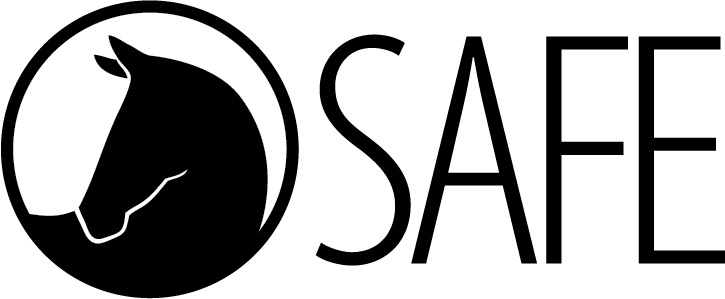SAFE ED Bonnie Hammond has had the privilege of working with Henry since his arrival at SAFE. Here’s what she has to say about their work together:
“The first challenge that Henry and I faced together was helping him understand that “walk” is a gait that he’s allowed and in fact encouraged to use. Like many of the Graham horses, Henry would set off like a bat out of hell when turned loose in the round pen. He’s got a rather gorgeous floaty trot, and he looks quite flashy when he’s going around at top speed with neck arched and his tail up in the air. But he needed help to understand that what we really want to see from him is relaxation. So while I taught Henry he could relax, he taught me how to alter my feel in a more subtle manner. It doesn’t take much to make Henry move forward, and he always stays pretty focused on his handler, so before too long he learned that he could walk or trot slowly and still be regarded as a good horse.
“Henry has weak stifles that “stick” from time to time, especially when he’s moving in a smaller circle or backing up. So we added trot poles to our routine to help strengthen his hind legs. Henry is a total pro when it comes to trot poles, and his movement over poles is breathtaking. His stifles seem to be improving, but we’re still seeing them stick, especially when the weather is colder. When they stick, he usually just gives a little kick and works it out himself. But we’re not yet 100% sure if we’re going to start him as a riding horse, due to this issue.
“Introducing the flag was a bit more of a challenge, because Henry found that piece of fabric on a stick VERY alarming. He’s still a bit reactive to it, but he’s come a long way. Now we can pet him with the flag to show that it’s not so scary, and we can use it to add energy without him leaving the ground. He’s learning his groundwork very well. He’s so “light” that it’s pretty easy to guide him where we want him to go, but he still has habits like falling in at the shoulder that show themselves from time to time. A small reminder that he can’t move over top of his handler does the trick. As I said before, he’s always very focussed on his handler, which is good, but also a sign of his anxiety, which is not good. I try to reassure him that there’s nothing to worry about, and that he can handle anything I ask him to do. He’s a smart horse, and he tries very hard, all the time.
“I enjoy working with Henry so much. He’s a very sweet horse with a ton of try, and even though there are things that he finds scary, he tries very hard to be brave. I can’t help but admire him. He’s a good horse!”
